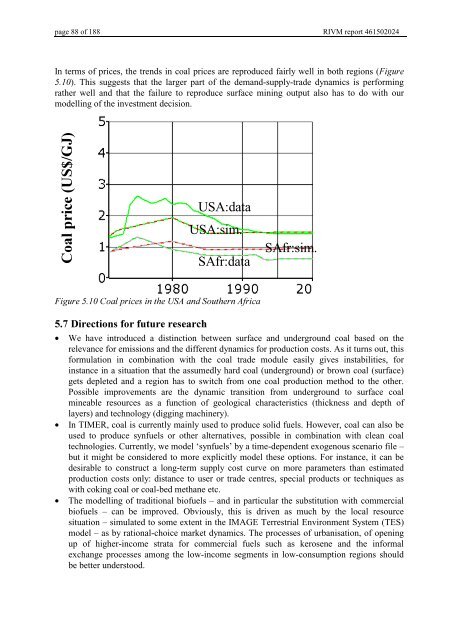Targets IMage Energy Regional (TIMER) Model, Technical ...
Targets IMage Energy Regional (TIMER) Model, Technical ...
Targets IMage Energy Regional (TIMER) Model, Technical ...
You also want an ePaper? Increase the reach of your titles
YUMPU automatically turns print PDFs into web optimized ePapers that Google loves.
page 88 of 188 RIVM report 461502024<br />
In terms of prices, the trends in coal prices are reproduced fairly well in both regions ()LJXUH<br />
). This suggests that the larger part of the demand-supply-trade dynamics is performing<br />
rather well and that the failure to reproduce surface mining output also has to do with our<br />
modelling of the investment decision.<br />
&RDOSULFH86*-<br />
USA:data<br />
USA:sim.<br />
SAfr:data<br />
SAfr:sim.<br />
)LJXUH&RDOSULFHVLQWKH86$DQG6RXWKHUQ$IULFD<br />
'LUHFWLRQVIRUIXWXUHUHVHDUFK<br />
• We have introduced a distinction between surface and underground coal based on the<br />
relevance for emissions and the different dynamics for production costs. As it turns out, this<br />
formulation in combination with the coal trade module easily gives instabilities, for<br />
instance in a situation that the assumedly hard coal (underground) or brown coal (surface)<br />
gets depleted and a region has to switch from one coal production method to the other.<br />
Possible improvements are the dynamic transition from underground to surface coal<br />
mineable resources as a function of geological characteristics (thickness and depth of<br />
layers) and technology (digging machinery).<br />
• In <strong>TIMER</strong>, coal is currently mainly used to produce solid fuels. However, coal can also be<br />
used to produce synfuels or other alternatives, possible in combination with clean coal<br />
technologies. Currently, we model ‘synfuels’ by a time-dependent exogenous scenario file –<br />
but it might be considered to more explicitly model these options. For instance, it can be<br />
desirable to construct a long-term supply cost curve on more parameters than estimated<br />
production costs only: distance to user or trade centres, special products or techniques as<br />
with coking coal or coal-bed methane etc.<br />
• The modelling of traditional biofuels – and in particular the substitution with commercial<br />
biofuels – can be improved. Obviously, this is driven as much by the local resource<br />
situation – simulated to some extent in the IMAGE Terrestrial Environment System (TES)<br />
model – as by rational-choice market dynamics. The processes of urbanisation, of opening<br />
up of higher-income strata for commercial fuels such as kerosene and the informal<br />
exchange processes among the low-income segments in low-consumption regions should<br />
be better understood.
















